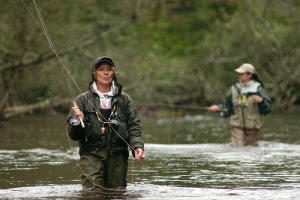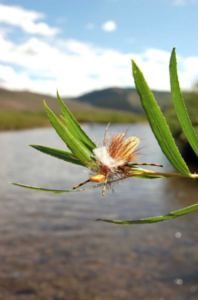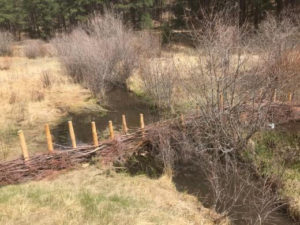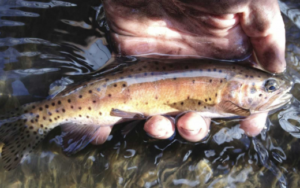How the Au Sable River Changed the Trout Fishing World
By CASEY WARNER
Michigan Department of Natural Resources
from The Fishing Wire

The Au Sable River is known throughout the country as a premier trout-fishing destination.
With the opener of Michigan’s trout season right around the corner, anglers soon will be donning their waders and heading out to one of the thousands of cold, quality streams that make the state a nationally known trout-fishing destination.
Perhaps the most renowned place to cast a fly in Michigan – the Au Sable River, running 138 miles through the northern Lower Peninsula – is significant for much more than its outstanding trout fishing.
In 1959, 16 fishermen, united by their love of trout and the Au Sable River and concerned about the need for long-term conservation of Michigan’s cold-water streams, gathered at George Griffith’s home east of Grayling.
“For some time I and several others have been considering ways and means to protect and preserve trout and trout fishing, and have come up with the idea of forming an organization to be known as Trout, Unlimited,” wrote Griffith, a member of the Michigan Conservation Commission, in an invitation letter to a fellow angler in 1959.
“Such an organization could work with state and federal agencies now charged with that responsibility … it would help educate the public on the dire need of sound, practical, scientific trout management and regulations to protect the trout as well as satisfy fishermen.”
The sportsmen that responded to Griffith’s invitation to meet at his cabin on the Au Sable believed that better and more scientific habitat management would improve the environment as well as the state’s trout population and fishing.
Nearly 60 years after that initial meeting, the organization those fishermen founded – Trout Unlimited – has become a national champion of fish habitat conservation.
Today, the organization has almost 300,000 members and supporters, with 30 offices nationwide, and sponsors the International Trout Congress.
The Michigan History Museum in Lansing is showcasing Trout Unlimited’s founding on the Au Sable in a special exhibition, “The River that Changed the World,” open through July 29.
“The Au Sable River has influenced – and continues to influence – people around the world,” said Mark Harvey, Michigan’s state archivist and the exhibition’s curator. “The stories in the exhibition demonstrate the innovative and unprecedented ways private citizens and state government worked together to conserve and protect the river and sustainably manage its fish populations.”
Original paneling and artifacts from the Wolverine fish car, which carried millions of fish by rail across Michigan, tell museum visitors the story of efforts to plant trout in the Au Sable.
Fred Westerman, one of the first employees of the Wolverine and former fisheries chief in the Michigan Department of Conservation, forerunner to the Michigan Department of Natural Resources, once reported:
“Frequently … thirty cans of fish would be dropped off at some spooky junction – like in the jack pine at Au Sable-Oscoda with the cemetery across the tracks and the depot a mile from town – on the night run of the Detroit & Mackinac, to await the morning train going up the river branch.”
The exhibition also introduces the relationship between the Anishinabe (Odawa and Ojibwe people) and the Au Sable River and explores Grayling as a fishing and tourism hotspot since the mid-19th century.
Harvey said that the idea for the exhibit stemmed from the Michigan History Center’s longstanding relationship with, and eventual donation of materials from, Art Neumann, one of the cofounders of Trout Unlimited and its executive director from 1962 to 1965.
“Instead of just focusing on the Trout Unlimited group, we took a wider view of the river that inspired these people to work for systemic change,” Harvey said.
The exhibition features George Griffith’s 24-foot-long Au Sable river boat and a re-creation of Neumann’s Wanigas Rod Shop, where he made fly rods considered works of art and became known as a champion of conservation.
A “battery” of glass beakers from the Grayling fish hatchery, each of which held thousands of eggs, highlights the late 19th-century work of state conservationists and private citizens who tried to save the Arctic grayling.
An iconic cold-water fish that once dominated northern Michigan streams but was almost extinct by the beginning of the 20th century, Arctic grayling were native only to Michigan and Montana in the lower 48 states.
“When sportsmen first discovered the grayling in the Au Sable, it drew international attention,” Harvey said.
The current Michigan Arctic Grayling Initiative now aims to restore self-sustaining populations of the fish within its historical range in Michigan.
Current DNR Fisheries Chief Jim Dexter applauded the vision and passion of those who recognized the Au Sable’s promise as a premier fishing destination.
“As the name of the exhibit implies, the Au Sable is a world-class fishery resource attracting anglers from every corner of the earth,” Dexter said. “It’s one of the most stable groundwater-influenced watersheds in North America, and produces exceptional trout fishing.
“It wasn’t always that way, though. Without the creation of Trout Unlimited at the Au Sable River, by those who understood the potential of our cold-water resources, Michigan might not be home to one of the world’s greatest trout fisheries.”
Trout Unlimited’s work has also encouraged other groups like the Anglers of the Au Sable, who now lead the charge for preserving this unique, high-quality body of water. Dubbed the “river guardians,” the Anglers group has fought multiple environmental threats to river.
The exhibit and related events also offer opportunities for hands-on experiences.
Visitors can learn how to tie a fly and compare tied flies to real insects under a microscope or sit in a kayak and take a 360-degree virtual reality paddle down the Au Sable.
They can also explore the essence of the Au Sable without leaving mid-Michigan through a series of museum programs revolving around the exhibit.
“While the exhibit focuses on the wonderful stories, images and sounds of the river, we wanted to bring the Au Sable River to the capital region,” said Michigan History Center engagement director Tobi Voigt. “We designed a series of programs highlighting themes from the exhibit – like fly-fishing and kayaking – that can be enjoyed by a variety of age groups. We’re especially excited to showcase a fly-fishing star and host our first-ever kayak tour.”
Programs include a fly-casting workshop with noteworthy fly-tier and fly-fishermen Jeff “Bear” Andrews, a kayak tour on the Red Cedar River, and the Second Saturdays for Families series featuring hands-on activities like making a compass, a sundial or a miniature boat.
To learn more about “A River That Changed the World” and to find Michigan History Museum visitor information, go to www.michigan.gov/museum.
Check out previous “Showcasing the DNR” stories at www.mi.gov/dnrstories. Subscribe to upcoming articles and other DNR publications at the bottom of our webpage at www.mi.gov/dnr.



